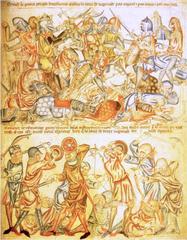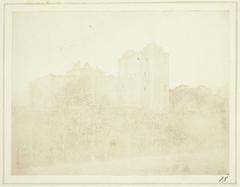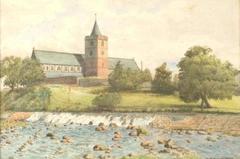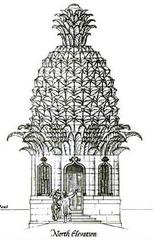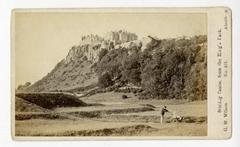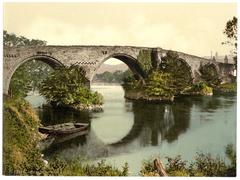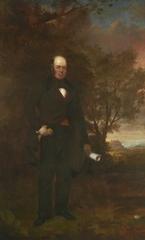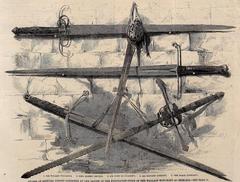
Cambuskenneth Abbey: Visiting Hours, Tickets, and Historical Guide in Stirling
Date: 04/07/2025
Introduction
Situated just east of Stirling, Cambuskenneth Abbey is a remarkable testament to Scotland’s medieval heritage, blending religious significance, royal connections, and unique architectural features. Founded around 1140 by King David I of Scotland, the abbey played a pivotal role in both the spiritual and political life of the nation. Hosting parliaments during the Wars of Independence and serving as the burial place for King James III and Queen Margaret of Denmark, Cambuskenneth Abbey is a must-visit for those interested in Scotland’s past. This guide provides comprehensive information on visiting hours, tickets, accessibility, site highlights, and nearby attractions to help you plan an enriching visit.
For up-to-date details, consult the Historic Environment Scotland official site, VisitScotland, and local historical blogs (A. Dotchin Blog).
Table of Contents
- Historical Overview
- Visiting Information
- Architectural Highlights
- Site Layout and Visitor Navigation
- Nearby Attractions
- Guided Tours and Events
- FAQs
- Planning Your Visit
- References and Further Reading
Historical Overview
Foundation and Early Development
Founded by King David I around 1140, Cambuskenneth Abbey was initially called the Abbey of St Mary of Stirling. It was the only Arrouaisian house in Scotland, with monks following a strict, reform-minded routine. Its strategic location near Stirling Castle strengthened its ties to the monarchy and made it influential in both ecclesiastical and political spheres (A. Dotchin Blog).
Papal Recognition and Royal Patronage
The abbey gained papal protection in 1147 from Pope Eugene III and received regular reaffirmation from subsequent popes. Its name changed to Cambuskenneth around 1207, as noted in papal documents. The abbey’s wealth and power grew thanks to royal patronage and extensive land grants, making its abbots key figures in Scottish governance.
Role in the Wars of Independence
During the Scottish Wars of Independence, Cambuskenneth Abbey was both a political and symbolic site due to its proximity to Stirling Castle. After the Battle of Bannockburn in 1314, Robert the Bruce distributed the spoils of victory at the abbey. The abbey also hosted a significant parliament in 1326, affirming the succession of Bruce’s son, David (Daily Record).
Royal Burials and Late Medieval Importance
The abbey became the final resting place for important royals. King James III, slain at the Battle of Sauchieburn in 1488, and his queen, Margaret of Denmark, who died in 1486, were interred here. Their tomb, restored during Queen Victoria’s reign, remains a central feature of the site (A. Dotchin Blog).
Reformation and Decline
The Reformation in 1560 led to the abbey’s dissolution, with its stones repurposed for other buildings. While the monastic community disbanded and much of the abbey was destroyed, the bell tower, some foundations, and the royal tombs survived.
Archaeological Remains and Restoration
Today, visitors can see the 13th-century freestanding bell tower, one of Scotland’s finest examples of early Gothic architecture. Archaeological work has revealed the original church layout, cloister, and remains of ancillary buildings, offering insights into medieval monastic life (Historic Environment Scotland).
Visiting Information
Opening Hours and Admission
- April to September: Open daily, 9:30 am – 5:30 pm (last entry 5:00 pm)
- October to March: Closed
Entry is free for all visitors, but donations are encouraged to support ongoing conservation (Historic Environment Scotland).
Tickets
No tickets are required for general entry. Occasionally, special events or guided tours may require advance booking.
Accessibility
- The site is largely level with grassy and uneven areas. The bell tower is not wheelchair accessible.
- Some interpretive panels and paths are accessible with assistance.
- Assistance dogs are welcome.
- For tailored support, contact Historic Environment Scotland.
Travel Tips
- Location: Ladysneuk Rd, Cambuskenneth, Stirling FK9 5NG (dayouthub.com)
- Getting There: About a 20-minute walk east from Stirling Castle via Ladysneuk Road or a short taxi ride.
- Parking: Limited street parking in Cambuskenneth village. Please be considerate of residents.
- Dress: Wear sturdy footwear and bring weather-appropriate clothing, as the site is exposed to the elements.
Architectural Highlights
The Bell Tower
A rare example of a freestanding monastic bell tower dating back to the 1200s, the structure was restored in the 19th century. The ground floor is open to visitors, showcasing medieval grave markers and architectural fragments.
The West Doorway and Foundations
The Romanesque west doorway is the only substantial superstructure remaining from the original church. The foundations of the nave, choir, and transepts are visible, with interpretive signage helping visitors envision the abbey’s full scale (Historic Environment Scotland).
Ancillary Buildings and Burial Ground
Remnants of workshops and a watergate, indicating the abbey’s economic role, lie west of the main site. The adjacent burial ground contains medieval markers and the restored tomb of James III and Margaret of Denmark.
Site Layout and Visitor Navigation
The site sits on a natural floodplain meander of the River Forth, offering seclusion and scenic beauty. Marked paths and interpretive boards guide visitors through the abbey’s remains, with panoramic views across the river to Stirling Castle.
Nearby Attractions
Stirling is rich in historical sites. Consider combining your abbey visit with:
- Stirling Castle
- National Wallace Monument
- Church of the Holy Rude
- Battle of Bannockburn Visitor Centre
- Stirling Smith Art Gallery & Museum
- Outdoor activities in the Ochil Hills
Guided Tours and Events
While regular guided tours are not always available, special tours and events are occasionally offered by local heritage groups. Check the Historic Environment Scotland, DayOutHub, or Stirling City Heritage Trust for upcoming opportunities.
Frequently Asked Questions (FAQ)
Q: What are Cambuskenneth Abbey’s opening hours?
A: Daily, 9:30 am – 5:30 pm, from 1 April to 30 September. Closed in winter.
Q: Is there an admission fee?
A: No, entry is free; donations are appreciated.
Q: Are guided tours available?
A: Guided tours are occasionally offered; check local listings or book in advance for special events.
Q: Is the abbey wheelchair accessible?
A: The site is mostly flat but may be uneven. The bell tower is not accessible. Contact Historic Environment Scotland for details.
Q: Are there facilities on-site?
A: Facilities are limited. Toilets and refreshments are available in Stirling or Cambuskenneth village.
Planning Your Visit
- Check Opening Hours: Confirm seasonal opening times before your visit.
- Combine Attractions: Enhance your trip by visiting nearby Stirling sites.
- Bring Essentials: Pack water, snacks, and suitable clothing.
- Respect the Site: Help preserve this scheduled monument by staying on paths and not climbing on the ruins.
- Photography: Early morning or late afternoon offer the best light for photographing the abbey and its surroundings.
For guided audio tours and additional resources, consider the Audiala App.
Summary
Cambuskenneth Abbey offers a unique window into Scotland’s medieval past, encompassing spiritual devotion, royal authority, and architectural heritage. Free admission, atmospheric ruins, and proximity to other major Stirling attractions make it a must-see. Plan your visit with attention to opening hours, accessibility, and weather, and enhance your experience with audio guides or guided tours for deeper insight.
References and Further Reading
- Historic Environment Scotland - Cambuskenneth Abbey
- VisitScotland - Cambuskenneth Abbey
- A. Dotchin Blog - Stirling: Scotland’s Historic Heart
- DayOutHub - Cambuskenneth Abbey
- Daily Record - Popular Scottish Tourist Sites
- Audiala App - Audio Guides for Scottish Historic Sites
- Canmore - Cambuskenneth Abbey
- Scran - Cambuskenneth Abbey








